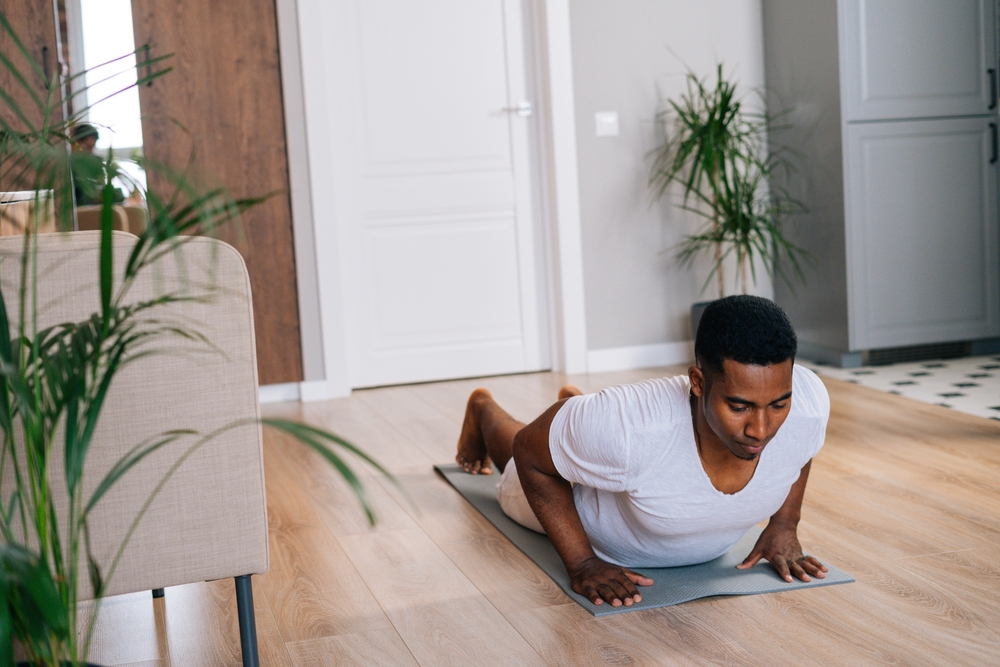Ever feel like you need a gym full of fancy equipment to get a decent workout? Think again. There’s a secret weapon in the fitness world that requires zero gear but delivers maximum results. And the best part? You can do it anywhere.
We’re talking about a move that targets your core, chest, shoulders, triceps, quads, and glutes all at once. It’s like getting a full-body gym session from a single exercise. Let’s dive into this fitness game-changer that might just revolutionize your workout routine.
The humble but mighty burpee
The burpee stands alone in its ability to skyrocket your heart rate while simultaneously building strength across your entire body. This workout chameleon is part cardio, part strength training, and entirely effective.
What makes the burpee so special is its compound nature. By moving through multiple positions rapidly, you engage different muscle groups in quick succession, creating both strength and cardiovascular benefits.
The six-pack secret
Your core works overtime during burpees, stabilizing your body through every phase of the movement. From the plank position to the explosive jump, your abdominals never get a break. This constant tension is exactly what builds that coveted six-pack and, more importantly, functional core strength that helps in everyday activities.
Many people struggle with finding effective core exercises that don’t strain their neck or back. The beauty of the burpee is that it strengthens your core while you’re focused on the other movements, almost like sneaking vegetables into a child’s favorite dish.
Chest and triceps transformation
When you drop into the push-up portion of a burpee, you’re essentially performing one of the most effective upper body exercises known to fitness. Your chest muscles control the descent and push, while your triceps activate to extend your arms.
What’s remarkable about the burpee’s push-up component is that it happens when your muscles are already under stress from the other movements. This creates a more challenging environment for muscle growth than isolated exercises.
The push-up advantage
The push-up phase hits your chest from the clavicular head to the sternal portion, working both the upper and lower pectoral muscles. Meanwhile, your triceps get the kind of activation that normally requires cable machines or specialized equipment.
Regular burpees can replace entire chest and tricep workout routines, especially for those short on time or equipment. Just 50 burpees can deliver the same chest and tricep activation as much longer isolation workouts.
Shoulder definition without weights
Shoulders are notoriously difficult to develop without equipment, but burpees manage to target them effectively through the plank-to-push-up transition and the explosive arm drive during the jump phase.
The deltoids work isometrically during the plank, then dynamically as you move through the exercise. This creates the kind of well-rounded shoulder development that many bodyweight routines miss entirely.
The anterior deltoid focus
Your front shoulder muscles get particular attention during burpees, which is great news since these muscles contribute significantly to that athletic, V-tapered look many fitness enthusiasts want.
The constant stabilization required during the movement also engages the smaller rotator cuff muscles that are crucial for shoulder health but often neglected in traditional workouts.
Lower body blast
While many people think of burpees as primarily an upper body exercise, your legs are actually doing much of the heavy lifting. Each rep effectively works your quads through the squat component and jump, while your glutes power the explosive upward movement.
Think of it as combining a squat jump with upper body work, creating a more efficient total package. Your legs have to generate enough force to propel your entire body weight upward, creating significant muscle activation.
The quad builder
The squat portion of a burpee hits your quadriceps hard, especially when you focus on proper form with knees tracking over toes and a full range of motion. Many people who add burpees to their routine notice quad definition improving within weeks.
What’s particularly effective is the rapid switch from eccentric loading as you lower into the squat to explosive concentric contraction as you jump. This transition creates optimal conditions for muscle development.
Glute activation secrets
Your posterior chain gets serious attention during burpees, particularly your gluteal muscles. The explosive hip extension required for the jump targets these muscles intensely, helping to build the kind of functional glute strength that supports everything from sports performance to daily activities.
Many people struggle with “dead butt syndrome” from excessive sitting. Burpees combat this by requiring full glute engagement through multiple planes of movement.
The jump factor
The power jump component of a burpee is where the glute activation reaches its peak. By focusing on driving through your heels and fully extending your hips at the top of the movement, you can maximize gluteal recruitment.
This explosive component is what separates burpees from many other bodyweight exercises, creating the kind of power development that translates to improved athletic performance across various activities.
Cardio and strength in one package
Perhaps the most impressive aspect of burpees is their dual nature as both strength and cardio exercise. Few movements can claim to build muscle while simultaneously training your cardiovascular system.
This one-two punch makes burpees incredibly time-efficient. A 10-minute burpee workout can deliver benefits comparable to much longer split routines that separate cardio and strength training.
The metabolic magic
The intense nature of burpees creates a significant oxygen debt, forcing your body to work hard to recover even after you’ve finished exercising. This “afterburn effect” means you continue burning calories at an elevated rate for hours following your workout.
Just 10 burpees every minute for 10 minutes can create a metabolic response similar to much longer training sessions, making it perfect for busy schedules.
Mastering proper form
Like any exercise, form matters enormously with burpees. Poor execution not only reduces the benefits but can also increase injury risk. Here’s how to ensure you’re getting maximum results safely.
Starting position
Begin standing with feet shoulder-width apart. Bend your knees slightly to prepare for the movement. Keep your weight centered and core engaged.
The drop
Lower your hands to the floor while simultaneously kicking your feet back to land in a plank position. Your body should form a straight line from head to heels. Avoid letting your hips sag or pike upward.
The push-up
Lower your chest to the floor with elbows at roughly a 45-degree angle from your body. Push back up to the plank position, maintaining a rigid torso throughout.
The jump
Jump your feet forward toward your hands, landing in a squat position. Immediately drive through your heels to jump upward, reaching arms overhead for maximum height.
The landing
Land softly with knees slightly bent to absorb impact, immediately preparing for the next repetition. The softer your landing, the more sustainable your burpee practice becomes.
Customizing for your fitness level
One of the best aspects of burpees is their scalability. No matter your current fitness level, there’s a burpee variation that can challenge you appropriately.
Beginner modifications
If standard burpees feel too challenging, start by removing the push-up component. Simply drop to a plank position, then jump your feet forward without lowering your chest to the ground.
Alternatively, you can step back into the plank rather than jumping back, reducing the cardiovascular demand while still engaging all the target muscles.
Advanced variations
Once standard burpees become too easy, add a challenge by incorporating additional elements. Consider adding a tuck jump at the top of the movement, bringing your knees toward your chest during the jump phase.
For serious athletes, weighted burpees using a weighted vest or holding light dumbbells can create even greater strength demands while maintaining the cardiovascular benefits.
Integration into your routine
The versatility of burpees makes them easy to incorporate into almost any fitness regimen. Here are some effective ways to add them to your workout routine.
The burpee finisher
After completing your regular workout, try adding 50 burpees for a metabolic finisher that will leave you gasping for breath but reaping tremendous benefits.
The burpee EMOM
Every Minute On the Minute workouts pair perfectly with burpees. Try performing 10-15 burpees at the start of each minute, resting for the remainder before beginning again at the top of the next minute.
The burpee ladder
Start with one burpee, then add one each round until you can no longer maintain proper form. This progressive overload approach creates a natural intensity curve that challenges even seasoned athletes.
Next time you’re short on time or equipment, remember that this single movement can deliver a comprehensive workout targeting six major muscle groups simultaneously. The humble burpee might just be the most efficient exercise in your fitness arsenal.















